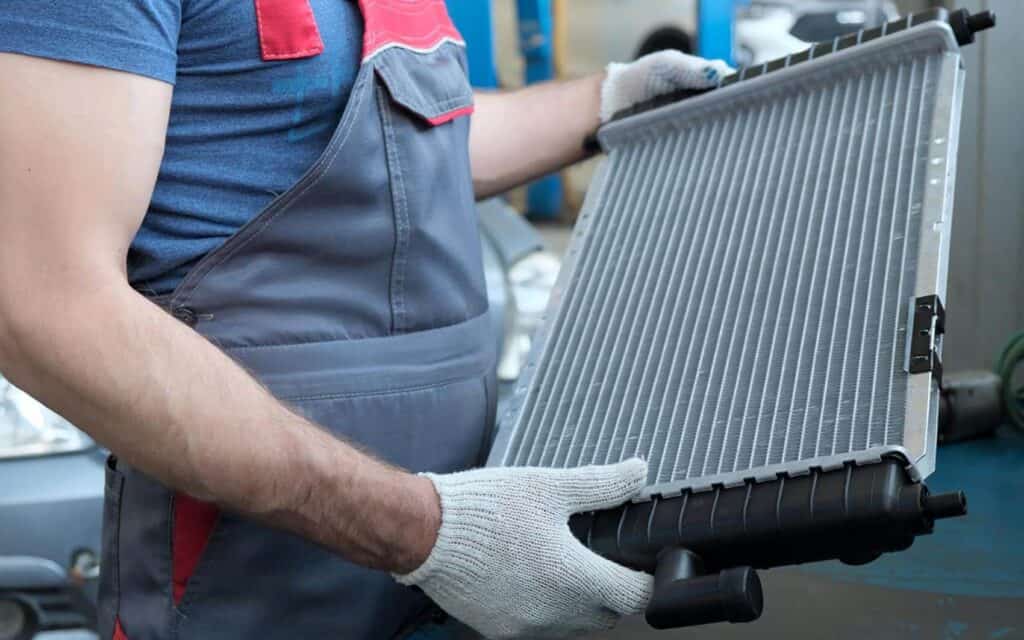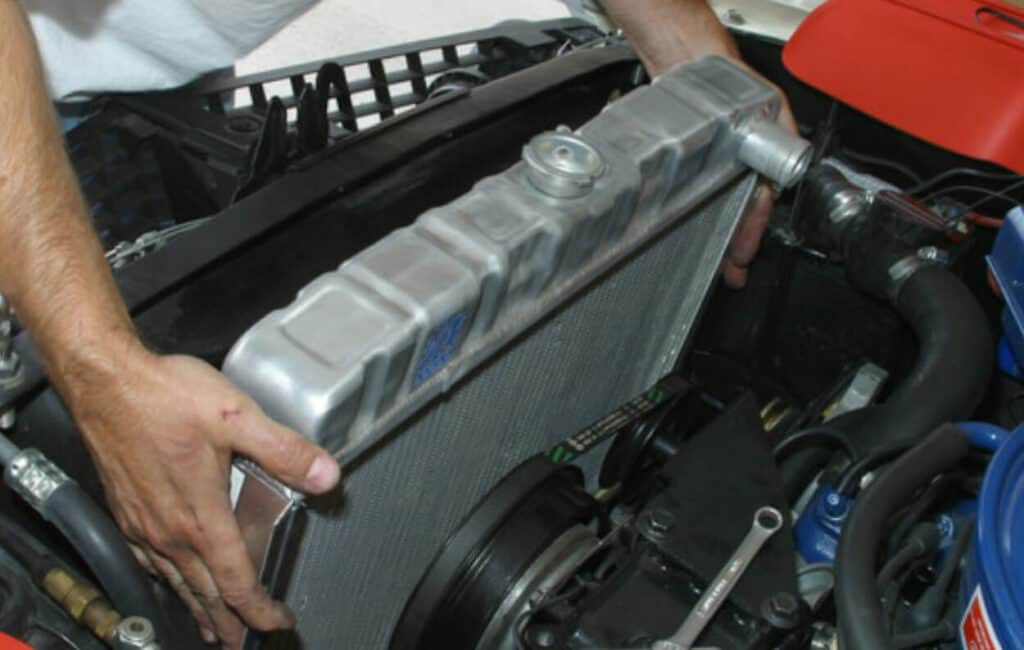The Radiator – Heartbeat of Your Vehicle’s Cooling System
Have you ever wondered, “What do I need when buying a new radiator?” The answer starts with understanding the essence of the radiator itself. Often described as the heartbeat of your vehicle’s cooling system, the radiator is essential for regulating the temperature of the engine. Its performance can be the difference between a smooth ride and a disastrous breakdown. Hence, making an informed choice is not just a matter of preference but of paramount importance.
Lifespan & Legacies: How Long Does a Radiator Really Last?
Radiators, much like the age-old trees in ancient forests, have lifespans that tell tales of their endurance and service. When one ponders, “What is the average lifespan of a radiator?”, the answer often meanders between timelines rather than fixed years. On average, a radiator’s life stretches between 8 to 10 years. But, like most averages, this isn’t a hard and fast rule for every vehicle.
The substance from which a radiator is forged plays a pivotal role in its longevity. For instance, aluminum radiators, popular for their lightweight nature and efficient heat dispersion, may not last as long as their brass or copper counterparts. However, they make up for it with better cooling capabilities.
Environmental conditions are another piece of this longevity puzzle. A radiator battling the high temperatures of scorching deserts or the rust-invoking moisture of coastal areas may face more challenges than one cruising through temperate climates. The harsher the conditions, the more the toll it takes on the radiator’s lifespan.
But the most impactful factor? Your care regimen. The more attentive and proactive you are in detecting and rectifying minor issues, the longer your radiator will serve you efficiently. Flushing the cooling system periodically, ensuring the coolant is of the right mixture and quality, and addressing leaks or damages promptly can significantly extend the life of your radiator. In this dance between machine and owner, your care choreography can lead the radiator to a performance deserving of a standing ovation.

Decoding the Dilemma: Repairing vs. Replacing Your Radiator
Diving deeper into the debate of repairing versus replacing, it’s akin to patching up a punctured boat or investing in a new one. For radiators with minor issues or recent models, repairs could be a practical choice. In scenarios where the radiator has a minor leak or a damaged fin, a repair can easily rectify the problem. It’s a quick solution, often less expensive than a complete replacement.
However, suppose the radiator has been serving you for years and has undergone multiple repairs. In that case, it might be reaching the end of its operational life. The metal might be corroding, the tubes clogging, or the fins deteriorating. Continuously repairing such a radiator can be likened to applying band-aid solutions to a deeper problem. Over time, frequent and accumulated repairs can even cost more than a one-time replacement.
Choosing to replace your radiator is a forward-looking decision. It ensures that your engine remains cool and performs optimally without the constant worry of recurring radiator issues. In the long run, a new radiator offers peace of mind, knowing that the core component safeguarding your engine from overheating is in prime condition.
Navigating the Market: OEM vs. Aftermarket Radiators
Delving into the world of radiators, one quickly encounters the age-old debate: OEM versus aftermarket. OEM, or Original Equipment Manufacturer, radiators are akin to buying designer brands. They come with a guarantee of quality, precise compatibility, and often a heftier price tag. These radiators are produced by the same companies that manufacture vehicles, ensuring that the radiator you purchase will fit and function seamlessly with your car model.
On the flip side, the realm of aftermarket radiators is vast and varied. Think of them as the bustling marketplace where numerous brands offer their versions of a product, each claiming superiority. While they might not carry the vehicle manufacturer’s badge, they’re not inherently inferior. Many aftermarket producers specialize in cooling systems, sometimes even offering enhancements or innovations not found in OEM versions. They can be more affordable, but the variance in quality is notable.
The trick in navigating this market is diligent research. Just as you would scrutinize products in a market, it’s essential to check reviews, certifications, and the reputation of aftermarket brands. Remember, a cheaper upfront cost might not always translate to long-term savings, especially if the radiator doesn’t last. On the other hand, a well-researched aftermarket purchase can provide the same, if not better, performance than its OEM counterpart at a fraction of the price.
Accessorizing Your Upgrade: Components to Replace with Your Radiator
When it comes to radiator replacement, people often focus solely on the radiator itself, overlooking the various smaller parts that work in concert with it. It’s akin to putting a brand-new engine in a car and neglecting to replace a worn-out transmission.
Firstly, consider the thermostat. This small but vital component controls the flow of coolant to the radiator. If your thermostat is faulty or old, your new radiator’s efficiency could be compromised. It’s prudent to replace the thermostat alongside the radiator to ensure a harmonious cooling system.
Next up are the hoses—both the upper and lower radiator hoses. These are the channels through which your coolant flows. Old, cracked, or leaky hoses can lead to cooling inefficiencies and even catastrophic engine failure. Replacing them when you’re already elbows deep in the engine bay simply makes sense. Plus, new hoses are relatively inexpensive and can save you future headaches.
Lastly, don’t forget the radiator cap. It may seem trivial, but the cap maintains the right pressure in your cooling system. A malfunctioning cap can lead to inefficiencies and, in extreme cases, can cause your radiator to explode. Given that a new cap is generally affordable, it’s a smart add-on to your shopping list.
So, when planning a radiator replacement, don’t isolate the procedure to just the radiator itself. Like an ecosystem, every part contributes to the overall well-being of your vehicle’s cooling system. Addressing these often-neglected elements can prolong the lifespan and efficiency of your new radiator and prevent future hiccups.
DIY vs. Delegating: Evaluating If You Should Replace Your Radiator Yourself
While the DIY route offers a sense of accomplishment and potential cost-saving, it’s imperative to weigh that against the skill, time, and resources required:
• Skill Level: The first consideration is your own mechanical aptitude. Replacing a radiator isn’t like changing a tire; it involves a fair bit of expertise. You should be comfortable with car anatomy and basic mechanical tasks to venture into this territory.
• Tool Availability: Essential tools like wrenches, screwdrivers, and drain pans are required for the job. Make sure you have all the necessary gear before diving in. Missing tools in the middle of the process can be frustrating and counterproductive.
• Time Commitment: Expect to devote at least a few hours to the project. Time can be a significant factor if you need the car up and running as soon as possible. If you’re time-strapped, delegating the task to a professional is a wise option.
• Coolant Management: Dealing with coolant requires extra care. It’s a chemical mixture that should be handled safely, including proper disposal. Lack of experience in handling coolant can lead to spills that are hazardous for both you and the environment.
• Attention to Detail: The installation process involves a multitude of steps, such as connecting hoses and ensuring proper fits. One wrong move can lead to leaks or, worse, a damaged radiator. This underscores the importance of being meticulous throughout the process.
• Quality Assurance: Even if you successfully install the new radiator, how sure are you of its proper function? Professionals usually offer a warranty or at least some assurance of their work, which can provide peace of mind.
• Risk and Cost of Errors: Mistakes can be costly, both in terms of finances and safety. A poorly installed radiator can result in engine damage, potentially running up a much higher bill than if you’d opted for professional service in the first place.
• Learning Experience: On the flip side, successfully replacing a radiator can be a fulfilling learning experience. It could be the start of your journey toward becoming more mechanically savvy, saving you money on labor costs in the long run.
• Professional Oversight: If you’re straddling the fence between DIY and professional help, remember that some mechanics offer supervisory services. They can oversee your work, offering tips and corrections, thus offering a middle-ground solution.
Sometimes, a helping hand from a seasoned mechanic can make all the difference in the world.

Picking the Best: Guide to Choosing the Most Effective Radiator for Your Vehicle
Let’s start by discussing the materials. Radiators typically come in two primary materials: aluminum and plastic. Aluminum is light, highly conductive, and generally more expensive. It’s often the go-to choice for high-performance or heavy-duty vehicles. Plastic radiators are more budget-friendly and are perfectly sufficient for everyday driving conditions.
Another critical factor is compatibility. Always ensure that the radiator you choose is compatible with your vehicle make and model. Incompatible radiators can lead to a slew of issues, from inefficient cooling to outright engine damage.
You’ll also come across a term known as “cooling capacity.” This defines how effective the radiator is in reducing heat. For instance, if you have a high-performance car or live in a particularly hot climate, a radiator with higher cooling capacity is a wise investment. Also, take note of the warranty and what it covers. A warranty can serve as a confidence booster in the product you’re buying and can provide some peace of mind.
The effectiveness of a radiator is subjective to your needs. If you drive a high-performance vehicle or live in a hot climate, you may need something more robust. On the other hand, if your driving is more on the modest side, a standard radiator will likely suffice.
To make the right choice, align your needs with your budget and vehicle requirements. Research thoroughly, read reviews, and consider seeking advice from professionals. With the right balance between quality, compatibility, and budget, you can drive away, knowing your vehicle is as cool as a cucumber—thanks to your well-chosen radiator.
Armed with Knowledge, Ready for the Road
Understanding the ins and outs of radiators equips you with the knowledge to make informed decisions, directly impacting your vehicle’s efficiency, performance, and lifespan. And remember, while some tasks can be DIY, having expert oversight ensures the best results. For those in Canada seeking professional assistance, Uchanics provides top-notch mobile mechanic services to guide you every step of the way.
